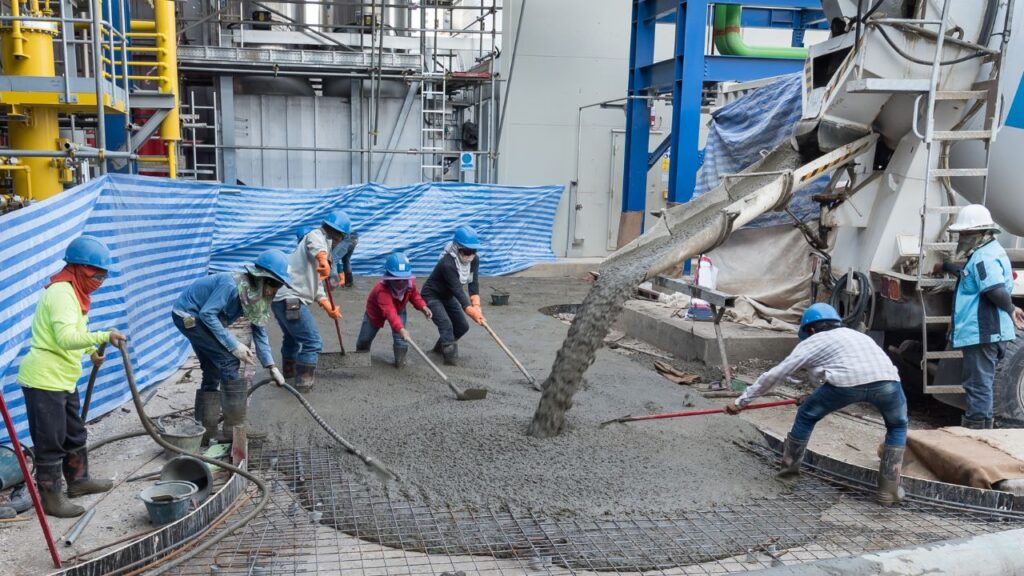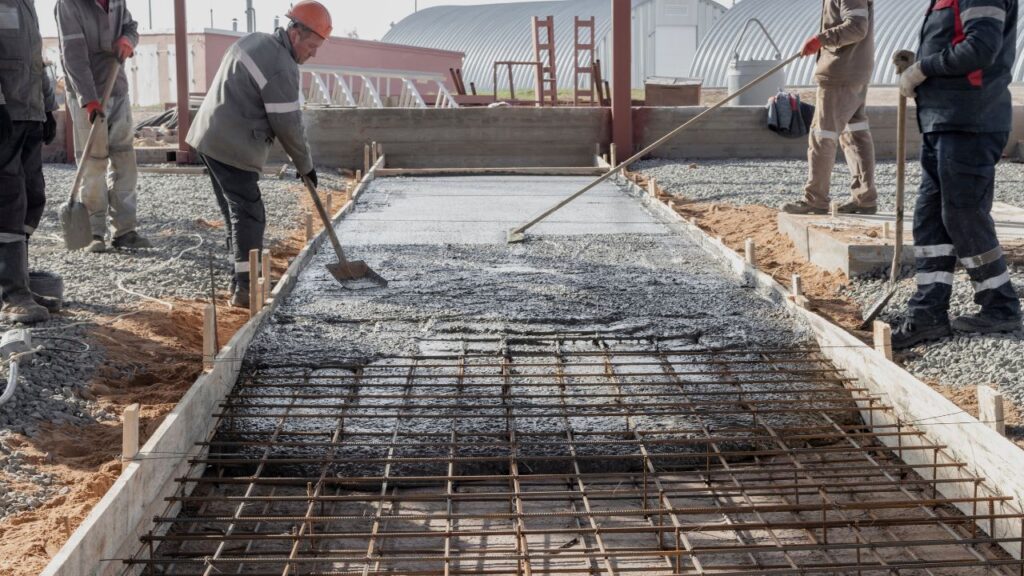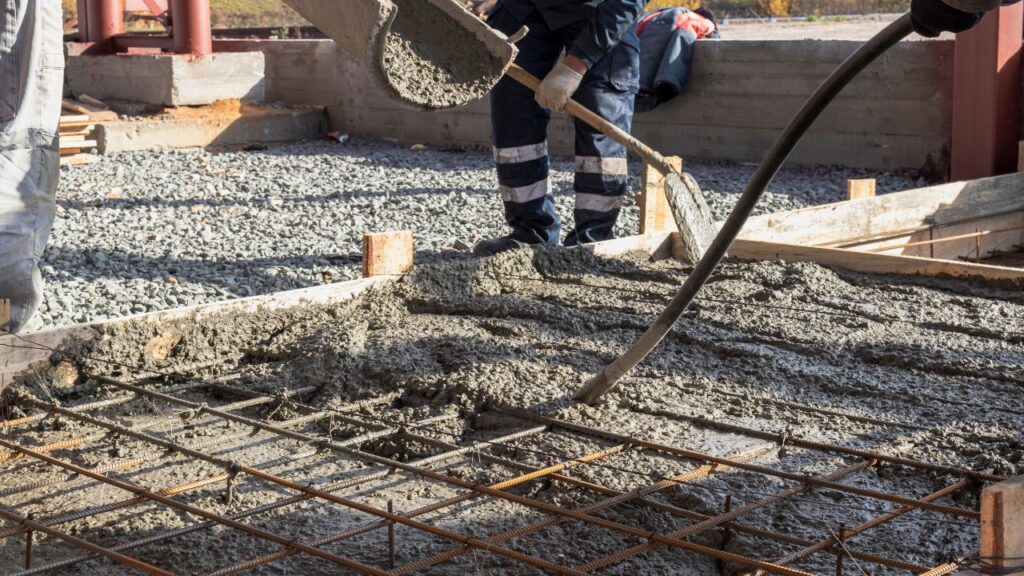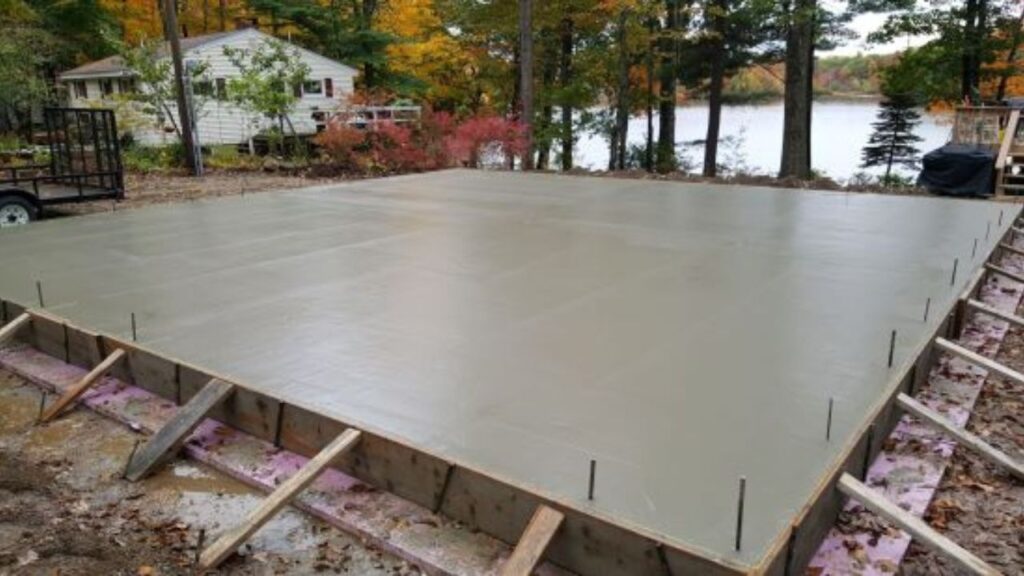Concrete Cost Estimator
Consult our experts for a concrete cost estimate tailored to your project. Make informed decisions and budget effectively with our assistance.

Accurate concrete construction estimating is the linchpin of successful building projects. It goes beyond mere number-crunching; it’s the meticulous process of predicting and managing the costs associated with every aspect of a construction endeavor. From the initial project assessment that defines the scope and objectives to the nitty-gritty calculations of concrete materials and labor costs, each step in the estimation process is crucial. Choosing the right equipment and machinery, considering overheads, and planning for contingencies are all integral to developing precise estimates.

With the advent of advanced technology, methods like Building Information Modeling (BIM) and historical data analysis have revolutionized the field, offering powerful tools for more accurate projections. Collaborative estimation and a commitment to continuous improvement round out this multifaceted discipline. By honing the art of concrete construction estimating, professionals not only safeguard project budgets but also ensure that the structures they build stand strong and sturdy for generations to come.
Accurate estimations in concrete construction are akin to a masterful conductor orchestrating a symphony. Precision in estimating costs is paramount, as it ensures that every dollar is allocated judiciously, every resource is utilized optimally, and every potential financial pitfall is anticipated and mitigated. The ramifications of inaccurate estimations can reverberate throughout a project’s lifecycle, leading to costly delays, resource shortages, and compromised quality. By contrast, spot-on estimations form the bedrock of fiscal responsibility and project success, instilling confidence in stakeholders and laying the groundwork for a seamless construction journey.
Concrete Cost Estimator
Consult our experts for a concrete cost estimate tailored to your project. Make informed decisions and budget effectively with our assistance.

The landscape of concrete construction costs is a multifaceted terrain, where various factors interplay to determine the final estimate. Understanding these intricate dynamics is paramount for any estimator or project manager:
Defining the scope and objectives of a construction project is akin to drawing the project’s boundaries on a detailed map. It’s about answering fundamental questions: What are the ultimate goals of the project? What specific work falls within the project’s scope? This step is pivotal, as it sets the stage for all subsequent estimations. Without a crystal-clear understanding of these fundamental parameters, estimations can quickly veer off course, leading to budget overruns and scope creep. By articulating the scope and objectives, project stakeholders ensure that everyone is on the same page, aligning efforts towards a common goal and minimizing the risk of misunderstandings down the road. This phase also lays the foundation for project planning, procurement, and resource allocation, making it a cornerstone of successful concrete construction projects.
The site evaluation is the bedrock upon which precise and realistic cost estimations are constructed. A construction site is far from a blank canvas; it’s a dynamic and diverse environment influenced by myriad factors. This evaluation phase delves into these complexities, taking into account critical aspects such as terrain, topography, soil quality, and accessibility. Terrain variations can necessitate special foundation considerations, while topography can impact site layout and grading requirements. Understanding the soil composition is vital for determining the type and depth of foundation needed.

Accessibility considerations encompass transportation routes for materials and equipment, which can significantly affect logistics and costs. Conducting this comprehensive site assessment ensures that estimations are deeply rooted in the reality of the project’s physical context, thereby mitigating the risk of unforeseen challenges that could escalate costs. It’s the preliminary step that ensures the estimate reflects the true nature of the construction endeavor.
In the complex landscape of concrete construction estimating, navigating the intricate web of local building codes and regulations is non-negotiable. Regulatory compliance isn’t merely a legal obligation; it’s an ethical imperative and a cornerstone of responsible construction practices. Ignoring or failing to account for these mandatory requirements can have dire consequences, ranging from costly delays to legal ramifications, fines, or even project shutdowns. Estimators and project managers must be well-versed in the specific regulations governing the project’s location, whether they pertain to zoning, environmental impact, safety standards, or structural codes. Every aspect of the estimate must align seamlessly with these standards to ensure not only legal compliance but also the ethical responsibility of constructing safe and environmentally sound structures. Integrating regulatory compliance into the estimation process is a strategic move that keeps the project firmly grounded in both the law and ethical practices, safeguarding not only its budget but also its reputation. It’s a commitment to constructing not just structures but also a legacy of integrity and responsibility within the construction industry.
Estimating the quantity of concrete required for a project is a meticulous process that requires precision. It’s akin to solving a complex mathematical equation where various variables must be carefully considered. Factors that influence the calculation of concrete material requirements include:
The human element is equally significant in concrete construction estimating. Labor force considerations delve into the workforce required for the project, emphasizing that the skilled labor force needed should never be underestimated. Key aspects to address in this context include:
When it comes to optimizing productivity and minimizing costs in a construction project, the selection of the right equipment and machinery is paramount. Each project has its unique demands, so it’s essential to carefully consider these requirements when making your choices.
One crucial factor to assess is the scale and scope of the project. For larger projects, heavy-duty machinery such as excavators, bulldozers, and cranes may be necessary to handle the workload efficiently. Conversely, smaller projects may benefit from compact equipment like mini-excavators or skid-steer loaders to navigate tight spaces.

Environmental considerations also play a significant role in equipment selection. If your project demands eco-friendly practices, you might opt for electric or hybrid machinery to reduce emissions and noise pollution. Moreover, the availability of skilled operators should influence your choice, as specialized machinery may require operators with specific training and expertise.
Neglecting equipment maintenance is a costly mistake in the construction industry. Unexpected breakdowns can lead to project delays, downtime, and inflated repair expenses. To mitigate these risks, it is crucial to incorporate regular maintenance routines into your project’s budget and timeline.
Routine maintenance includes tasks such as oil changes, filter replacements, and inspections of critical components. Scheduling these activities at planned intervals can help identify potential issues before they escalate into major problems, preventing costly downtime. Additionally, adhering to manufacturers’ maintenance guidelines ensures that warranties remain valid and that equipment operates at peak efficiency.
Budgeting for maintenance costs is essential for accurate project estimation. A well-maintained fleet of machinery not only reduces the risk of unplanned expenditures but also enhances the overall safety and productivity of your construction project. So, while it may seem like an added expense, investing in equipment maintenance is a prudent decision that pays off in the long run.
In any construction project, administrative costs are an integral part of the budgeting process. These expenses encompass a wide range of essential functions, including project management, office overheads, and administrative staff salaries. Failing to account for administrative costs can lead to budget shortfalls and hinder the smooth execution of the project.
Properly allocating funds for administrative costs ensures that the project management team has the necessary resources to effectively plan, execute, and monitor the construction project. It also helps maintain transparency in financial planning and prevents unexpected financial burdens.
Construction projects are inherently susceptible to unforeseen challenges and disruptions. To mitigate the impact of these unexpected events, it’s imperative to include a contingency fund within the project estimate. This contingency serves as a safety net, allowing for flexibility in handling issues that could otherwise jeopardize the project’s timeline and budget.
Manual estimation is a meticulous process that entails a comprehensive analysis of various project components. This method relies on the expertise and industry knowledge of professionals to estimate the cost, time, and resources required for a construction project. During manual estimation, experienced estimators carefully examine project blueprints, material requirements, labor needs, and other relevant factors. They draw upon their past experiences and industry insights to make precise calculations.

While manual estimation can be time-consuming, it is often favored for its ability to provide highly accurate estimates. This method is particularly valuable for complex or unique projects where historical data or automated tools may not provide sufficient guidance.
In the modern era, technology has revolutionized the construction industry, offering specialized software designed explicitly for concrete construction estimating. These software tools are tailored to streamline the estimation process, making it more efficient, consistent, and precise. They provide a user-friendly interface that allows estimators to input project details, such as blueprints, materials, labor costs, and project timelines. The software then utilizes algorithms and databases to generate cost and time estimates based on this input. By automating many of the calculations and incorporating up-to-date pricing data, estimation software not only accelerates the estimation process but also enhances accuracy by reducing the risk of human error. Additionally, these tools often include features for tracking changes in project scope and costs as the project progresses, aiding in project management and budget control.
Comparative analysis is another approach used in construction estimating. This method involves comparing the current project to similar completed projects to derive estimates. By examining historical data from past projects with similar specifications and characteristics, estimators can identify patterns and trends in terms of cost, time, and resource allocation. This method relies on the assumption that past project data can serve as a reliable benchmark for estimating future projects. Comparative analysis can be performed manually or with the assistance of software tools, which can help identify relevant historical data more efficiently. However, the accuracy of estimates in comparative analysis depends heavily on the availability of comparable projects and the accuracy of data collected from those projects.
In this in-depth case study, we delve into the intricacies of a real-life residential construction project. This project provides a valuable opportunity to witness firsthand how concrete construction estimating principles are meticulously applied in practice. From the initial stages of project planning and cost estimation to the final stages of execution and quality control, we’ll explore the entire lifecycle of this residential construction endeavor. Through this comprehensive analysis, you will gain insights into the unique challenges, cost factors, and decision-making processes that shape the success of residential construction projects. Whether you are a seasoned professional in the construction industry or an aspiring estimator, this case study offers valuable lessons and practical knowledge to enhance your skills and understanding of concrete construction estimating.
Step into the world of complex commercial construction as we examine a dynamic case study featuring a commercial building project. This investigation provides an opportunity to comprehend the multifaceted nature of estimating costs for such endeavors and offers valuable insights drawn from the experiences of seasoned industry professionals. Delve into the intricacies of budgeting, resource allocation, and risk management that are integral to successful commercial construction projects. Through this case study, you will gain a deep appreciation for the various factors, such as zoning regulations, environmental considerations, and architectural specifications, that impact cost estimation and decision-making in commercial construction. Whether you are a project manager, estimator, or simply curious about the world of commercial construction, this case study will equip you with practical knowledge and a nuanced understanding of the challenges and triumphs in this sector.
Concrete construction estimating is the meticulous process of predicting and managing the costs associated with various aspects of a construction project involving concrete. This includes calculating costs for materials, labor, equipment, overheads, and contingencies to develop accurate project budgets.
Accurate estimating is crucial because it ensures that construction projects stay within budget, utilize resources efficiently, and avoid costly delays or quality compromises. It forms the foundation for responsible project management and financial responsibility.
Several factors impact concrete construction costs, including project location, concrete type and mix design, scope and complexity, site conditions, regulatory compliance, market dynamics, and economic factors. Estimators must consider these variables to develop precise estimates.
The initial project assessment defines the scope and objectives of a construction project, ensuring that all stakeholders understand the project’s goals. It sets the stage for accurate estimations, project planning, and resource allocation.
Site evaluation is crucial because it assesses the physical characteristics of the construction site, including terrain, topography, soil quality, and accessibility. These factors significantly impact construction costs and must be considered during estimation.
Regulatory compliance involves adhering to local building codes, safety standards, environmental regulations, and other legal requirements. Ignoring or neglecting compliance can lead to costly delays, penalties, and legal issues, making it a vital aspect of estimating.
Estimating concrete material requirements involves considering factors such as concrete mix design, formwork, reinforcement, waste and overages. Accurate measurements are crucial to optimize material usage.
Labor force considerations involve determining the number of workers, their skill levels, work shifts, and adherence to safety and compliance regulations. A skilled and well-managed labor force is essential for project success.
Choosing the right equipment and machinery is critical for optimizing productivity and minimizing costs. Factors such as project scale, environmental considerations, and operator expertise influence equipment selection.
Overheads cover administrative costs, including project management, office expenses, and administrative staff salaries. Contingencies are funds set aside for unexpected events or changes in the project scope. Both are essential for financial planning and project stability.
The world of concrete construction estimating is a multifaceted discipline that serves as the backbone of successful building projects. It encompasses meticulous planning, precise calculations, and a deep understanding of various factors that influence construction costs. Accurate estimations are not just about financial numbers; they are the cornerstone of fiscal responsibility and project success. Inaccurate estimations can lead to costly delays, resource shortages, and compromised quality, while spot-on estimations instill confidence in stakeholders and pave the way for a seamless construction journey. The key factors affecting concrete construction costs, such as project location, concrete type, scope, site conditions, regulatory compliance, market dynamics, and economic factors, all demand careful consideration during the estimation process. The initial project assessment, site evaluation, regulatory compliance, material and labor cost calculations, equipment selection, and maintenance planning are integral steps in crafting precise estimates. Incorporating overheads and contingencies, both in terms of time and cost, is essential for risk mitigation and budget management. Estimation methods, whether manual or aided by software, play a pivotal role in achieving accuracy. Real-world case studies in residential and commercial construction projects provide valuable insights into the practical application of these principles. Ultimately, by honing the art of concrete construction estimating, professionals ensure not only the safeguarding of project budgets but also the construction of structures that stand strong and sturdy for generations to come.
Here I am going to share some steps to get your concrete cost estimate report.
You can send us your plan on info@estimatorflorida.com
Before starting your project, we send you a quote for your service. That quote will have detailed information about your project. Here you will get information about the size, difficulty, complexity and bid date when determining pricing.
We do concrete estimating and prepare a detailed report for your project. At last, you finalize the report and finish the project.



561-530-2845
info@estimatorflorida.com
Address
5245 Wiles Rd Apt 3-102 St. Pete Beach, FL 33073 United States
561-530-2845
info@estimatorflorida.com
Address
5245 Wiles Rd Apt 3-102 St. Pete Beach, FL 33073 United States
All copyright © Reserved | Designed By V Marketing Media | Disclaimer